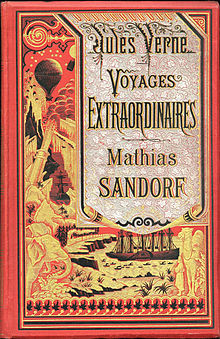Mathias Sandorf

Hetzel first edition cover
|
|
| Author | Jules Verne |
|---|---|
| Original title | Mathias Sandorf |
| Illustrator | Léon Benett |
| Country | France |
| Language | French |
| Series | The Extraordinary Voyages #27 |
| Genre | Adventure novel |
| Publisher | Pierre-Jules Hetzel |
|
Publication date
|
1885 |
|
Published in English
|
|
| Media type | Print (Hardback) |
| Preceded by | The Archipelago on Fire |
| Followed by | The Lottery Ticket |
Mathias Sandorf was an 1885 adventure book by French writer Jules Verne. It was first serialized in Le Temps in 1885, and it was Verne's epic Mediterranean adventure. It employs many of the devices that had served well in his earlier novels: islands, cryptograms, surprise revelations of identity, technically advanced hardware and a solitary figure bent on revenge. Verne dedicated the novel to the memory of Alexandre Dumas, pere, hoping to make Mathias Sandorf the Monte Cristo of Voyages Extraordinaires (The Extraordinary Voyages) series.
In Trieste, 1867, two petty criminals, Sarcany and Zirone, intercept a carrier pigeon. They find a ciphered message attached to its leg and uncover a plot to liberate Hungary from Habsburg-Austrian rule. The two meet with Silas Toronthal, a corrupt banker and form a plan to deliver the conspirators to the police in exchange for a rich reward. The three Hungarian conspirators, Count Mathias Sandorf, Stephen Bathory and Ladislas Zathmar (in their Hungarian form: Sándor Mátyás, Báthory István and Szatmári László, respectively) are arrested and sentenced to death. Only Sandorf can escape.
Fifteen years later, the renowned physician Dr. Antekirtt (actually Sandorf) sets out to avenge his friends. Enlisting the aid of two French acrobats, Pescade and Matifou, he scours the Mediterranean in search of those who planned the betrayal. Rich beyond all imagination, wielding great power and master of an island fortress filled with advanced weaponry, Dr. Antekirtt will not rest until justice is done.
In the generation after Dumas, Jules Verne wrote a number of Wanderer adventures. Three of the most notable, Michael Strogoff, the Steam House (La Maison à vapeur) and Mathias Sandorf, are set in three of Europe's great Empires: the Russian, the British (in India), and the Austrian. Their plots and themes have a good deal in common, as Jean Yves Tadie points out. Each one is about the empire's political troubles, each features a pursuer who is himself pursued, each has a trio of characters at its centre and each grants minor importance (compared with other Verne books) to machinery.
(From Seven Types of Adventure: An Eniology of Major Genre by Martin Green Penn State Press).
...
Wikipedia
